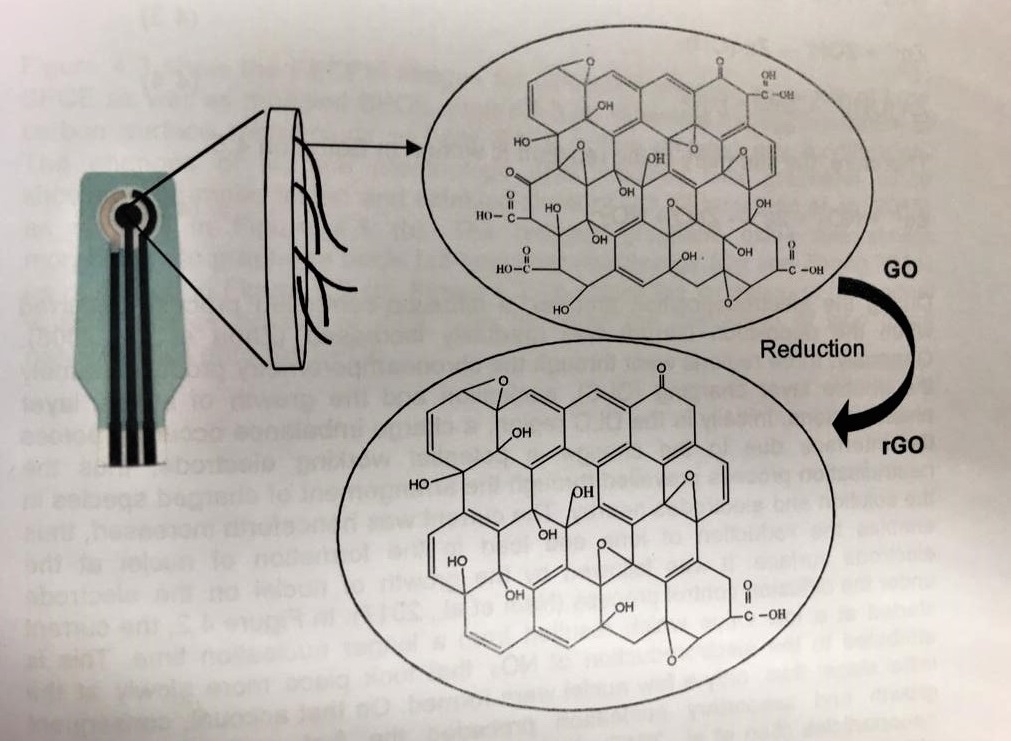Ganoderma boninense is a major disease that infects oil palm trees. This problem has caught researchers' attention all around the world, especially those from Asian countries as Ganoderma boninense is difficult to trace in its early stage. Undoubtedly, many researchers have lent a hand by suggesting ways to diagnose the disease through the introduction of many methods to detect symptoms related to the Ganodenna disease, including tomography, selective media, Indirect Enzyme-linked lmmunosorbent Assay (ELISA), and polymerase chain reaction (PCR). However, these diagnostic techniques are less accurate, time-consuming, and lead to cost increments. Therefore, another method to detect Ganoderma boninense at a faster, lower cost, and higher accuracy was introduced which is through the use of electrochemical sensors. Initially, electrode modification was done by reducing graphene oxide (GO) to reduced graphene oxide (rGO). Subsequently, the addition of zinc oxide nanoparticles (ZnO-NPs) was electrodeposited on top of it using the electrodeposition method. Both modifiers were chosen as they have been acknowledged to have large surface areas to interact with analytes, and have great electroconductivity. In this study, this disposable modified SPCE was used as a sensing material in order to detect secondary metabolites acting as possible biomarkers for the Ganoderma boninense disease in healthy and infected leaves at the 14 and 30 day periods. It is because secondary metabolites are produced once oil palm trees are infected by Ganoderma boninense. The combination of physical and electrochemical characterisation of graphene oxide (GO) before and after reduction together with the deposition of zinc oxide nanoparticles (ZnO-NPs) were observed using field emission scanning electron microscopy (FESEM), energy dispersive x-ray (EDX), Fourier Transform Infrared Spectroscopy (FTIR), Raman spectroscopy and cyclic voltammetry (CV) to reveal the successful modification of ZnO-NPs/rGO /SPCE.
As a consequence, the electrochemical analysis presented a current increment in each modification higher than the bare SPCE due to electrocatalytic activity. Afterwards, the electrochemical signals from secondary metabolites were indicated from differential pulse voltammetry techniques (DPV) under optimum conditions. ZnO-NPs/rGO/SPCE established a good correlation coefficient (R2) of both healthy and infected oil palm after 14 days and 30 days (R2 = 0.9691, R2 = 0.9652, R2 = 0.9905 and R2 = 0.9710) with detection limits of 1.52 ppm, 1.58 ppm, 3.20 ppm and 3.02 ppm respectively. Consequently, the outstanding sensing performance o·f ZnO-NPs/rGO/SPCE in the detection of secondary metabolites can be applied to control the Ganoderma boninense disease at the earlier stage before spreading out.

Modification of SPCE by Reduction of GO to RGO
*Abstract of the thesis (Master of Science) by Nurhamizah Rahmat
For further information please contact:
Professor Nor Azah Yusof, PhD
Chairman
azahy@upm.edu.my
Date of Input: 15/12/2021 | Updated: 15/12/2021 | roslina_ar
MEDIA SHARING























